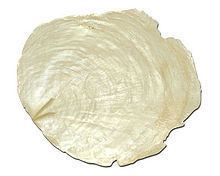Order Ostreoida Genus Placuna Higher classification Placuna | Scientific name Placuna placenta Rank Species | |
 | ||
Similar Haliotis rubra, Bivalvia, Abalone, Pinctada, Nautilidae | ||
Handcrafted capiz in the philippines
The windowpane oyster (Placuna placenta) is a bivalve marine mollusk in the family of Placunidae. They are edible, but valued more for the shells and pearls. The shells have been used for thousands of years as a glass substitute because of their durability and translucence. More recently they have been used in the manufacture of decorative items like chandeliers and lampshades. In this use the shell is known as capiz. Shells are also used as raw materials for glue, chalk, and varnish.
Distribution extends from the shallows of the Gulf of Aden, around India, then Malaysia to the southern South China Sea, and around the Philippines, where it is abundant in the eponymous province of Capiz. They are found in muddy or sandy shores, in bays, coves, and lagoons to a depth of about 100 m (330 ft).
Populations have been in decline because of destructive methods of fishing and gathering such as trawling, dredging, blast fishing and surface-supplied diving. In the Philippines, fisheries are now regulated through permits, quotas, size limits, and protected habitats. In spite of this resources continue to be depleted.
The almost-flat shells of the capiz can grow to over 150 mm (5.9 in) in diameter, reaching maturity between 70 to 100 mm (2.8 to 3.9 in); securing the shells is a V-shaped ligament. Males and females are distinguished by the color of the gonads. Fertilization is external and larvae are free-swimming like plankton for 14 days or attached to surfaces via byssal thread during metamorphosis, eventually settling on the bottom. They consume plankton filtered from the water passing through their slightly opened shell; the shell closes if the bivalve is above water during low tide.
Shells are used as a raw material in the manufacture of glue, chalk, varnish, window panes, chandeliers, and lampshades. The primary exporter of products is the Philippines, where it is known as kapis.
